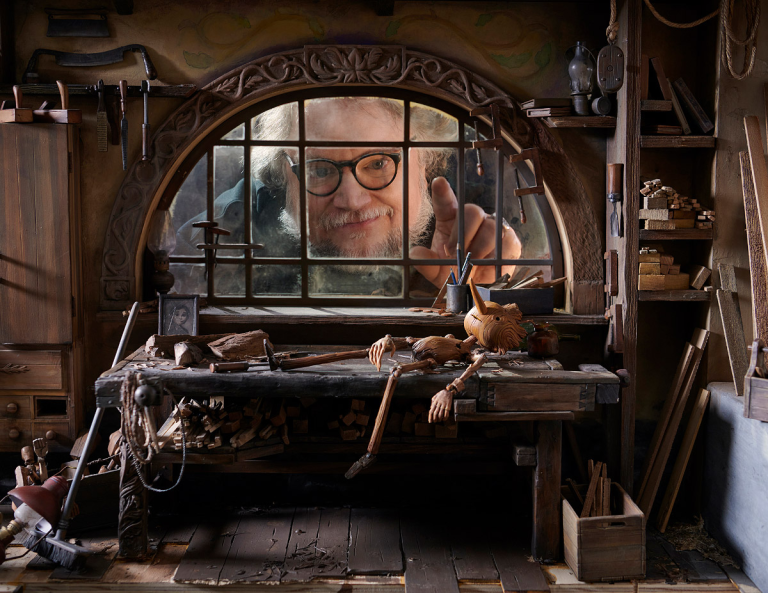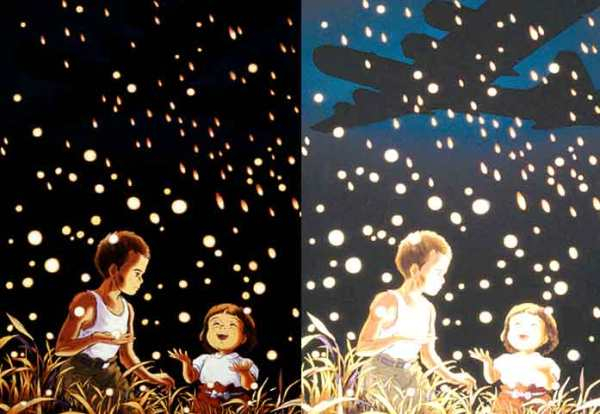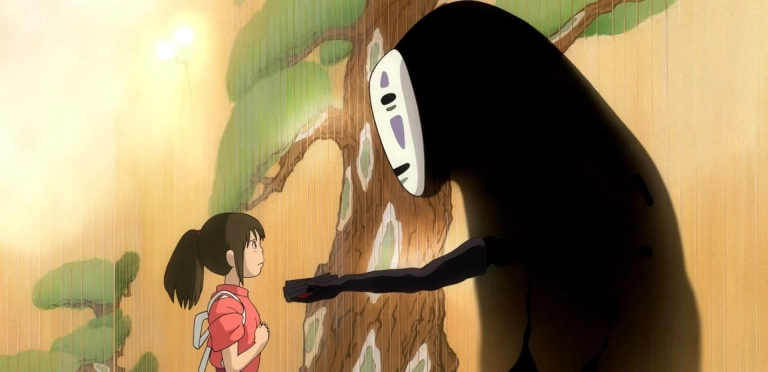Today is April 1st—April Fool’s Day—so it seems fitting to review a film about the most iconic liar of all time: Pinocchio. Specifically, Guillermo del Toro’s Pinocchio, which premiered on Netflix in late 2022 and won the Oscar for Best Animated Feature Film.
Directed by Guillermo del Toro, the film offers a fresh, emotional, and meaningful take on the well-known tale. Though I wasn’t a fan of Pacific Rim, Hellboy, or even The Shape of Water, I must admit that del Toro has crafted some remarkable works—like Pan’s Labyrinth, Nightmare Alley, and now, Pinocchio. Unlike many fairytale adaptations from Disney, this version breathes new life into the story. It’s not just a retelling, but a profound narrative about fatherhood, loss, and the horrors of war.
Warning: Spoilers Ahead
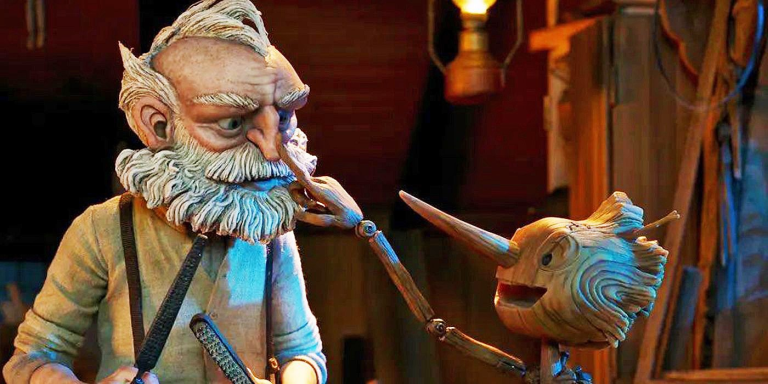
Set Against a Wartime Backdrop
The story takes place in southern Italy during World War II. As in the original, Geppetto is a skilled woodworker, but in this version, he first has a real son named Carlo. Tragedy strikes when a bomb falls on their church, killing Carlo. Grief-stricken, Geppetto creates Pinocchio in his son’s likeness. A forest spirit grants life to the wooden boy, but Pinocchio soon becomes a handful. Podestà, a fascist officer, is alarmed by Pinocchio’s rebelliousness and insists he be educated—and eventually, conscripted. But the free-spirited puppet is lured into a traveling circus, unaware that his father is desperately searching for him. This sets off a series of heartfelt and harrowing events.
A Poignant Father-Son Relationship
What stands out most is the emotional depth of the father-son bond. While the original tale cast Geppetto as a caring father figure, this film strengthens their connection by introducing Carlo. The early scenes between Geppetto and Carlo are deeply touching, making Carlo’s death all the more heartbreaking. Geppetto doesn’t create Pinocchio out of inspiration—but out of drunken sorrow and longing. At first, he sees Pinocchio as a nuisance, a poor substitute. However, as they spend time together, the boy’s mischievous but loving nature wins over his reluctant father. Pinocchio joins the circus to earn money for Geppetto, and ultimately sacrifices himself to save him from a sea monster.
Geppetto’s arc is equally powerful. Initially burdened by grief, he treats Pinocchio with detachment—disappointed that the puppet isn’t as obedient or gentle as Carlo. But when Pinocchio vanishes, he realizes how much he loves this imperfect, living creation. He sets off to find him, aware of the dangers that await a wooden boy in a war-torn country.
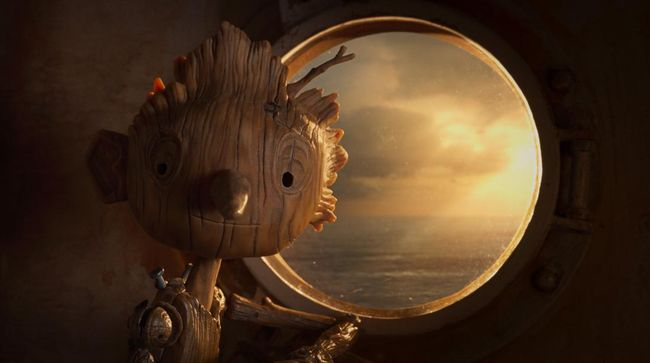
Powerful Anti-War Themes
Del Toro infuses the film with bold anti-war commentary. Set under Mussolini’s fascist regime, the narrative highlights the destructive impact of ideology. Carlo’s death by aerial bombing is an early symbol of senseless loss. Podestà, a fascist loyalist, views Pinocchio’s independence as a threat. He seeks to mold boys—his own son included—into ideal soldiers, pushing them to fight and suppress their individuality. During a brutal training scene, Podestà rejects a tie in a mock battle, declaring that war allows no draws—only victory or death.
The film doesn’t stop at subtle hints. Mussolini himself is mocked during a puppet show, and war is portrayed as dehumanizing and senseless. Ironically, Podestà meets his end by an anonymous bomb—killed not by his enemies, but possibly his own side.
Exposing Exploitation and Control
Pinocchio’s journey with the circus reveals yet another layer: exploitation. The circus owner profits off Pinocchio’s performances, pocketing the boy’s earnings and withholding support from Geppetto. A grumpy monkey serves as the villain’s assistant but later becomes an unexpected ally. Abused and disillusioned, the monkey sides with Pinocchio—another victim rising up against his oppressor.
The circus also serves as a metaphor for societal control. Puppetry is used not just literally but symbolically, representing how people can be manipulated—by fascism, by greed, or by fear.
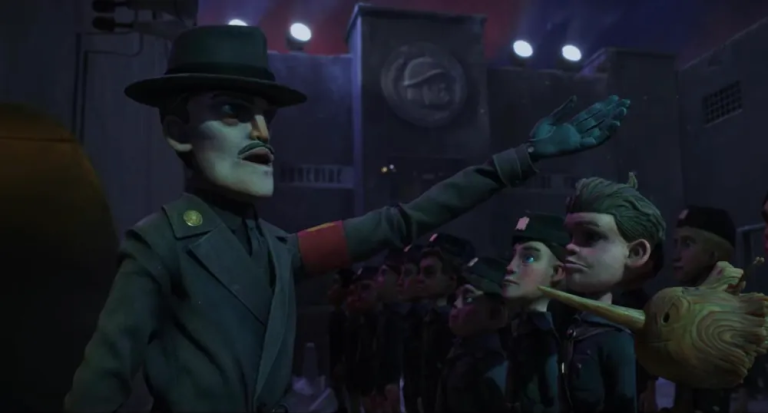
Rethinking Truth and Lies
In the original story, lying is the moral lesson: Pinocchio’s nose grows whenever he lies. This version doesn’t abandon that entirely—his nose does grow when he lies—but lying takes on more nuance. The most striking moment comes when Geppetto calls Pinocchio a burden. The boy is devastated, not because of what was said, but because his father’s nose didn’t grow—implying the hurtful statement was true.
Later, Pinocchio realizes that sometimes those who seem kind may be the biggest liars, while those who speak harsh truths may still love you deeply. In one clever scene, Pinocchio even uses his growing nose to escape the belly of the sea monster—demonstrating that lies, too, can have value in the right context.
Del Toro’s Magical Realism
True to del Toro’s signature style, the film is steeped in magical realism. One standout element is the afterlife sequence: because Pinocchio lacks a soul, he can’t truly die, but must spend time in the underworld before returning. Each death extends this limbo, as marked by an ever-larger hourglass. The urgency peaks when he must return quickly to save his father—but time has not yet run out.
The spiritual beings—especially the underworld god and forest sprite—add mythical layers reminiscent of Pan’s Labyrinth. The film’s blend of fantasy and moral allegory also calls to mind the gothic charm of Tim Burton’s Corpse Bride or The Nightmare Before Christmas.
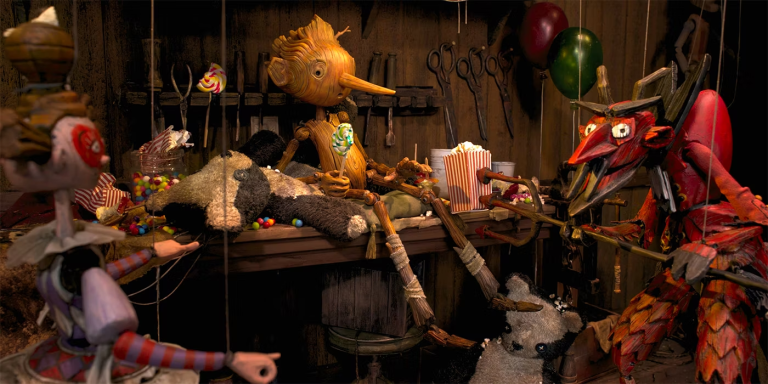
Stunning Stop-Motion Artistry
Lastly, the film’s stop-motion animation is a triumph. Like Kubo and the Two Strings or Isle of Dogs, every frame is meticulously crafted. The characters, sets, and transitions exude care and artistry, creating an emotionally rich and visually striking experience. Special mention goes to the soundtrack—especially the song “Ciao Papa,” which is both haunting and heartfelt.
Minor Weaknesses
If there’s one flaw, it lies in the film’s final act. Returning to the familiar sea-monster climax, the story loses some of its earlier freshness. While the execution is heartfelt—especially Pinocchio’s sacrifice—it doesn’t quite match the emotional power of the circus and wartime segments. Personally, I would have preferred the war narrative as the emotional crescendo.
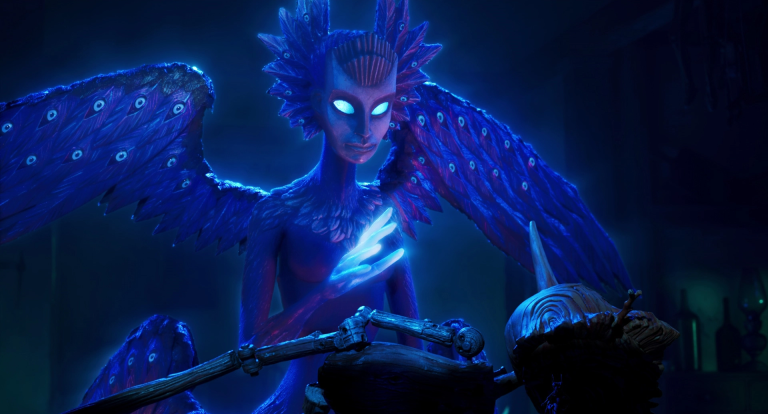
Conclusion
Overall, Pinocchio is a remarkable animated film. It breathes life into a timeless tale, adding layers of emotion, political insight, and spiritual wonder. It’s a story about grief, growth, rebellion, and love—one that’s well-deserving of its Oscar win for Best Animated Feature. A visual and emotional masterpiece that reminds us: even puppets can have hearts.

